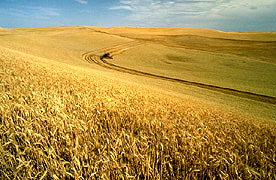This page has been archived and is being provided for reference purposes only. The page is no longer being updated, and therefore, links on the page may be invalid.
Reaping More Rewards from Crop Residues
By Ann PerryJune 12, 2009
Wheat and barley producers in Washington State's Palouse region can refine crop residue management to build soil organic matter, curb soil erosion, retain soil moisture and maximize crop yields, thanks to support from the Agricultural Research Service (ARS).
ARS soil scientist Ann Kennedy and Tami Stubbs of Washington State University (WSU) worked with other WSU and ARS colleagues to conduct a two-year study of post-harvest crop residues to identify links between decomposition processes and fiber and nutrient characteristics of the straw. Kennedy works at the ARS Land Management and Water Conservation Research Unit in Pullman, Wash.
The researchers looked at residues from 17 cultivars of winter wheat, 16 cultivars of spring wheat and nine cultivars of spring barley grown at four locations in southeastern Washington. The team measured the content of hemicellulose, cellulose and lignin in each type of residue. They also measured residue levels of carbon and nitrogen and the ratio of the amount of carbon to nitrogen (C/N).
The team found that the straw from the different cultivars had notable differences in fiber composition and C/N ratios. Fiber composition, C/N ratios and carbon levels also varied significantly by location, probably because of different soil and growing conditions. Residue samples from Pullman, where annual precipitation averages 20 inches, had higher lignin and C/N and lower nitrogen than residues from the driest site, where annual precipitation averages 11 inches.
These results and other tests on the straw residues indicated that 14 percent of the cultivars had characteristics for slow residue decomposition and 14 percent had characteristics indicating a potential for rapid decomposition. Crop residues decompose into soil organic matter, which provides nutrients to crops, limits erosion and helps retain soil moisture. Rapidly decomposing cultivars are less likely to impede no-till seeding in higher rainfall areas where more straw is produced.
The identification of differences in these crop characteristics could help growers select cultivars that produce residues best adapted to reduced-tillage cultivation. These residues may also benefit subsequent crop establishment, maximize soil organic matter to improve yield and increase carbon stored in the soil.
ARS is the principal intramural scientific research agency of the U.S. Department of Agriculture.

